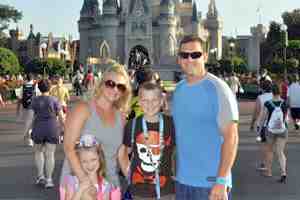Subscribe Now: 1 Full Year of WDW For Only $24.97!
Get full access to the WDW Crowd Calendar, Lines Mobile App, Touring Plans and More!

"Our TouringPlans subscription was a lifesaver on our trip. One of the busiest days of the year, and we never waited longer than 20 minutes!"
- Smith Family, KY
The largest of Animal Kingdom's lands, Africa is entered through Harambe, a Disneyfied version of a modern rural African town. A market is equipped with modern cash registers; dining options consist of a sit-down buffet, limited counter service, and snack stands. What distinguishes Harambe is its understatement: Far from the stereotypical great-white-hunter image of an African town, Harambe is definitely (and realistically) not exotic. The buildings, while interesting, are architecturally simple. Though better maintained and more idealized than the real McCoy, Disney’s Harambe would be a lot more at home in Kenya than the Magic Kingdom's Main Street would be in Missouri.
Harambe serves as the gateway to the African veldt habitat, Animal Kingdom’s largest and most ambitious zoological exhibit. Access to the veldt is via the Kilimanjaro Safaris attraction, at the end of Harambe’s main drag near the fat-trunked baobab tree. Harambe is also the departure point for the train to Rafiki's Planet Watch and Conservation Station (the park’s veterinary headquarters), as well as the home of a long-running live theatrical show in Festival of the Lion King. A lovely walkway between Africa and Pandora connects two of Disney's best-themed lands.
Attractions
Also in Africa...
Africa represents the most "urban" environment in the Animal Kingdom. Inspired by an island town called Lamu off the east coast of Kenya, the Swahili style structures represent a village that has learned to benefit by conserving nearby natural resources and become a tourist destination. It has a main street and the safari's entrance next to a baobab tree (a real tree) acts like Cinderella Castle in the Magic Kingdom and draws you forward. The roof over the entrance was weaved by thirteen thatchers from Zululand in South Africa. The grass roof is expected to last thirty to forty years. The Imagineers say it is "so imperfect, it's perfect."
The spark of imagination that solidified this version of African as the central theme was a visit to Lake Nakuru, a popular safari park in Kenya. As described by Imagineer Kevin Brown, the group was driving around the park looking for animals in jeeps. Over the radio came the call that somebody has spotted a leopard in the tree. By the time Kevin's truck made it to the spot, there were more than forty vehicles with people hanging out taking photos. This is when the light bulb went off for Joe Rohde, Executive Designer and Vice President, Creative for Walt Disney Imagineering.
As Kevin describes it, "Africa is a theme park - just not a particularly well-run one. We knew the experience we could provide in the Animal kingdom would be as good as or better than that". So they created the fictional town of Harambe. Harambe is Swahili for "let us all pull together". The village is layered in history with the walls of the ancient fort and canyons behind the Dawa Bar standing guard. There are remnants of the time when the area was under British colonial control.
Now there is evidence that the local economy is focused on conservation. The safari is the big draw and the locals manage the savannah. They collectively fear poaching which threatens the ecosystem and their livelihood. The historic buildings have been readapted to accommodate the tourist trade with a hotel, a bar, a restaurant and other necessary facilities. The posters on the walls reinforce the commercial nature of the village.
Dining
- Dawa Bar (Bar or Lounge)
- Harambe Fruit Market (Food Stand or Cart)
- Harambe Market (Quick Service)
- Kusafiri Coffee Shop and Bakery (Food Stand or Cart)
- Lion King Ice Cream and Hot Dog Cart (Food Stand or Cart)
- Mahindi (Food Stand or Cart)
- Tamu Tamu Refreshments (Quick Service)
- Tusker House Restaurant (Table Service)
- Zuri's Sweet Shop (Quick Service)

